S'sonic
Stealth
Menu
A free template by Lucknowwebs.com for WYSIWYG WebBuilder 8
Powered by Sispro1-S
Nigel G Wilcox
Paragon Of Space Publication
© Copyright Reserved - United Kingdom
Ideal Screen Composition 1024 x 768
SITEMAP
PSEUDO SCIENCE
SCIENCE RESEARCH
ABOUT
Desk
Supersonic
Stealth
Study
Menu
MAIN INDEX
Fastest Air Planes
Space
Transport
Menu
Mikoyan MiG 29 Fulcrum
General Characteristics
Crew: 1
Length: 17.32 m (56 ft 10 in)
Wingspan: 11.36 m (37 ft 3 in)
Height: 4.73 m (15 ft 6 in)
Wing area: 38 m² (409 ft²)
Empty weight: 11,000 kg (24,250 lb)
Loaded weight: 14,900 kg (33,730 lb)
Max. takeoff weight: 18,000 kg (44,100 lb)
Fuel capacity: 3,500 kg (7,716 lb) internal
Powerplant: 2 × Klimov RD-33 afterburning turbofans, 81.59 kN (18,342 lbf) each
Performance
Maximum speed:
At high altitude: Mach 2.25 (2,400 km/h; 1,490 mph)
At low altitude: Mach 1.21 (1,500 km/h; 930 mph)
Range: 1,430 km (888 mi; 772 nmi) with maximum internal fuel
Ferry range: 2,100 km (1,300 mi; 1,130 nmi) with 1 drop tank
Service ceiling: 18,000 m (59,100 ft)
Rate of climb: 330 m/s (65,000 ft/min) (initial); 109 m/s (21,500 ft/min) (average) (0-6,000 m)
Wing loading: 403 kg/m² (82 lb/ft²)
Thrust/weight: 1.09
Maximum g-load: 9 g
Armament
Guns: 1 × 30 mm Gryazev-Shipunov GSh-301 autocannon with 150 rounds
Hardpoints: 7 × hardpoints (6 × underwing, 1 × fuselage) with a capacity of up to 4,000 kg (8,800 lb) of stores and provisions to carry combinations of: Rockets:
S-5
S-8
S-24
Missiles:
4 × R-27R/ER/T/ET/P air-to-air missiles
4 × R-60 AAMs
2 × R-73 AAMs
Bombs: 6 × 665 kg (1,466 lb) bombs
Avionics
Phazotron Rubin radar
Phazotron Zhuk-ME radar
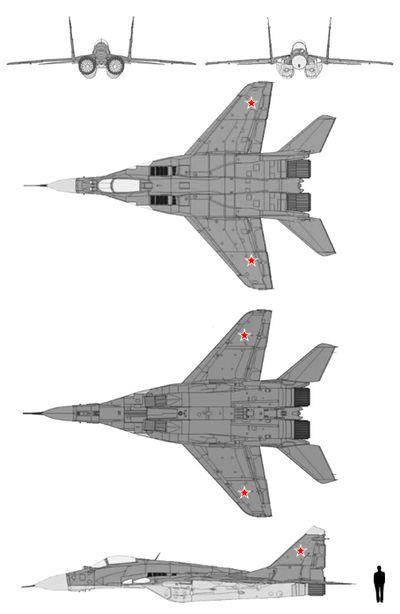
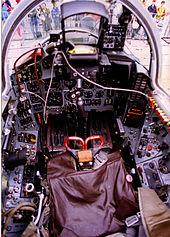
Role: Air superiority fighter, multirole fighter
National origin: Soviet Union / Russia
Manufacturer: Mikoyan
First flight: 6 October 1977
Introduction: July 1982
Status: In service
Primary users: Russian Air Force
Indian Air Force
Ukrainian Air Force
Produced: 1981-present
Number built: 1,600+
Unit cost: US$11 million (MiG-29B, 1999)
US$22 million (MiG-29C, 2013)
Variants: Mikoyan MiG-29M
Mikoyan MiG-29K
Mikoyan MiG-35
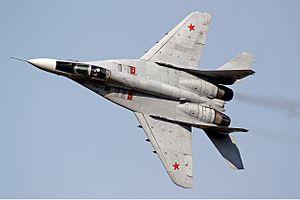
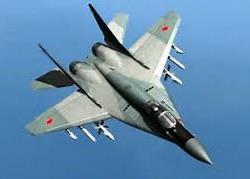
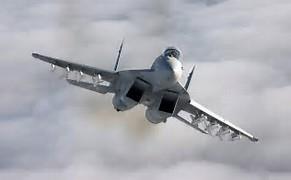
The MiG-29K fighter bomber aircraft is manufactured by RSK MiG and the Irkutsk Aircraft Production Association Joint Stock Company. The MiG-29, 30 and 33 are known by the Nato code name Fulcrum.
The MiG-29K is the carrier-based version. It took off for its maiden flight in October 1977 and entered service in August 1983.
The mission of the MiG-29 is to destroy hostile air targets within radar coverage limits and to destroy ground targets using unguided weapons in visual flight conditions.
The aircraft's fixed-wing profile with large wing leading-edge root extensions gives good manoeuvrability and control at subsonic speeds, including manoeuvres at high angles of attack. The maximum operational g-loading is 9g.
A two-seater version, MiG-29M2, took its maiden flight in 2001. A super-manoeuvrable variant, MiG-29M OVT, with 3D thrust-vectoring engine nozzles was successfully demonstrated at the Farnborough International Airshow in July 2006. The nozzle has three hydraulic actuators mounted around the engine to deflect the thrust. The aircraft is being offered to potential customers as the MiG-35.
The Mikoyan MiG-29 (Микоян МиГ-29) is the embodiment of a Russian military aircraft. The interceptor and multirole fighter bomber MiG-29 uniquely combines unbelievable maneuverability with great speed. The first MiG-29 airframes were delivered to the Soviet airforce in 1983. The MiG-29 Fulcrum was exported to numerous countries: Until today, more than 1'500 aircraft in various versions of the air superiority fighter MiG-29 were built.
After Germany's reunification, a whole squadron of MiG-29 aircraft came into possession of the German airforces. Western military advisors were astounded by the MiG's performance after they analyzed its flight characteristics. No western fighter could rival the MiG on a similarly high level. The flight characteristics were only matched by modern aircraft like the Eurofighter EF2000 Typhoon or the Lockheed Martin F-22 Raptor, thirty years later. The MiG-29's flat fuselage contributes approximately 40% of the lift. This makes the MiG unbeatable, especially at low speeds. The further development of the MiG-29 OWT with 3D thrust vectoring amazes air show spectators with maneuvers that seem to defy physics - distractions that intend to disorientate enemy pilots. The "MiG Aircraft" was often used as an umbrella term for all Soviet-built aircraft. So sometimes you can see aircraft from other manufacturers like Suchoj being called a "MiG".
The flight and maneuvering capabilities at low speeds and/or at high angles of attack - essiential for close combat - are unrivaled by the MiG's western counterparts. The MiG-29 has two Klimow/Sarkisow RD-33 reheated turbofan engines, which each produce more thrust with afterburner then any single equivalent western engine.
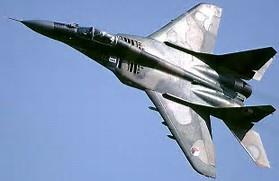

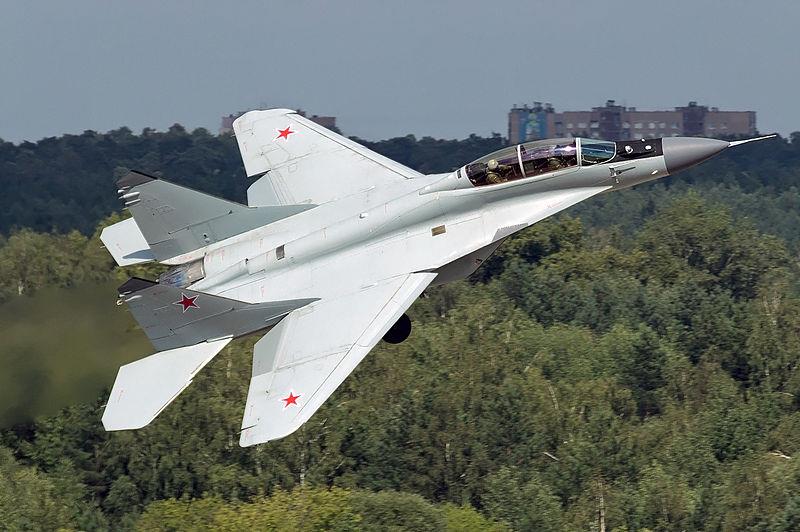
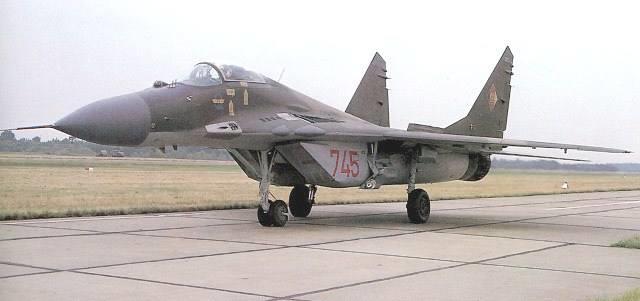
The Mikoyan MiG-29 is a twin-engine jet fighter aircraft designed in the Soviet Union. Developed by the Mikoyan design bureau as an air superiority fighter during the 1970s, the MiG-29, along with the larger Sukhoi Su-27, was developed to counter new American fighters such as the McDonnell Douglas F-15 Eagle, and the General Dynamics F-16 Fighting Falcon. The MiG-29 entered service with the Soviet Air Force in 1982.
Maiden flight: 06 Oct 1977 Length: 56.99 ft Wingspan: 37.24 ft Passengers: 1 Introduced: Aug 1983 Manufacturer: Russian Aircraft Corporation MiG













